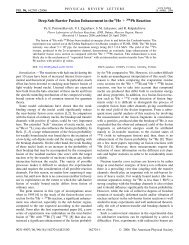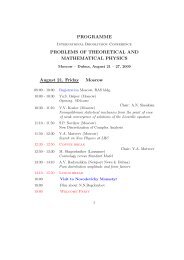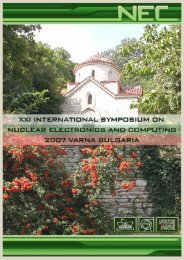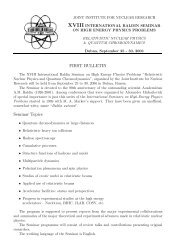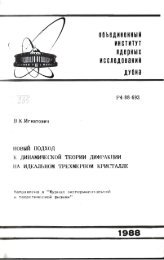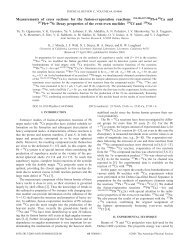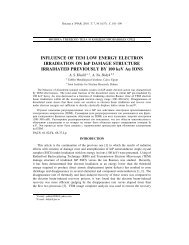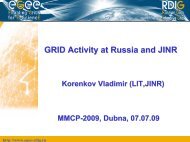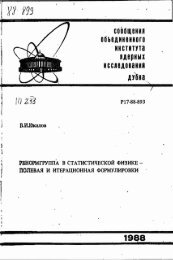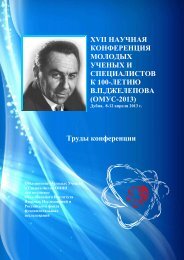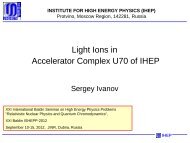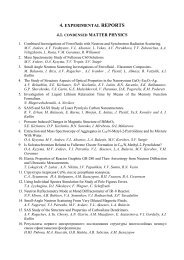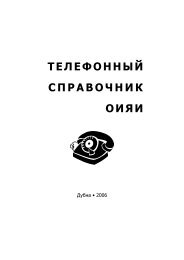Joint Institute for Nuclear Research Relativistic ... - Index of - JINR
Joint Institute for Nuclear Research Relativistic ... - Index of - JINR
Joint Institute for Nuclear Research Relativistic ... - Index of - JINR
Create successful ePaper yourself
Turn your PDF publications into a flip-book with our unique Google optimized e-Paper software.
THE SIGNALS OF PARTIAL RESTORATION OF CHIRAL SYMMETRY<br />
IN MEDIUM AT INTERMEDIATE ENERGY:<br />
EXPERIMENTAL DATA VS. THEORY<br />
S.M. Eliseev<br />
Bogoliubov Laboratory <strong>of</strong> Theoretical Physics ,<br />
<strong>Joint</strong> <strong>Institute</strong> <strong>for</strong> <strong>Nuclear</strong> <strong>Research</strong>, 141980 Dubna, Russia,<br />
E-mail: selis@theor.jinr.ru<br />
Hadrons, injected inside nuclei, apparently change some <strong>of</strong> their properties. The study<br />
<strong>of</strong> in-medium properties <strong>of</strong> hadrons has attracted quite some interest among experimentalists<br />
and theorists because <strong>of</strong> a possible connection with chiral symmetry restoration in<br />
hot and/or dense matter. Experiments using relativistic heavy ions are aimed to produce<br />
a system at very high densities and connected with that very high temperatures. In their<br />
dynamical evolution they run through various states, from an initial high-nonequilibrium<br />
stage through a very hot stage <strong>of</strong> a new state <strong>of</strong> matter (QGP). Any observed signal<br />
necessarily represents a time-integral over all these physically quite distinct states <strong>of</strong> nuclear<br />
matter. On the contrary, in experiments with microscopic probes on cold nuclei one<br />
tests interactions with nuclear matter in a well-known state, close to cold equilibrium.<br />
Even though the density probed is always smaller than the nuclear saturation density, the<br />
expected signals are as large as those from ultrarelativistic heavy-ion collisions.<br />
In this talk a variety <strong>of</strong> aspects <strong>of</strong> in-medium behavior <strong>of</strong> hadrons are reviewed with an<br />
emphasis on experimental data. Examples <strong>for</strong> theoretical predictions <strong>of</strong> in-medium effect<br />
from scattering and reaction processes with K + beams below 800 MeV/c are given. It is<br />
also emphasize that final state interactions can have a famous effect on observables and<br />
thus have to be intended as part <strong>of</strong> the theory. This is demonstrated with examples from<br />
neutrino-nucleus deep inelastic interactions. In the end, the possibility to obtain hadron<br />
<strong>for</strong>mation times in high-energy neutrino-induced reactions is demonstrated.<br />
44



